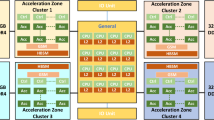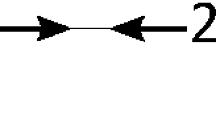Abstract
The LBM produces stencil numerical schemes which fall into the memory-bound domain. Therefore the performance may be multiplied if the arithmetic intensity is increased. In this paper, the data flow arrangement possibilities at the streaming step are explored while aiming for the development of the most efficient algorithms and implementations of the LBM schemes. The locally recursive non-locally asynchronous algorithm construction method is used for the purpose. This method is based on the analysis of the dependency graph of the task in the dD1T Minkowsky space. The schemes of well-known propagation patterns are illustrated and analyzed. With the knowledge of their advantages and drawbacks, the new propagation scheme is defined. The best propagation scheme which is constructed with this method is implemented as the program code for GPU. The description of the code and the performance results are provided. The obtained performance is up to 10 GLUps on a single nVidia GeForce RTX 3090 GPU.










Similar content being viewed by others
References
Bailey P, Myre J, Walsh SD, Lilja DJ, Saar MO (2009) Accelerating lattice boltzmann fluid flow simulations using graphics processors. In: International Conference on Parallel Processing, ICPP’09, pp. 550–557. IEEE. https://doi.org/10.1109/ICPP.2009.38
Geier M, Schönherr M (2017) Esoteric twist: an efficient in-place streaming algorithms for the lattice boltzmann method on massively parallel hardware. Computation 5(2):19. https://doi.org/10.3390/computation5020019
Habich J, Zeiser T, Hager G, Wellein G (2009) Enabling temporal blocking for a lattice Boltzmann flow solver through multicore-aware wavefront parallelization. In: 21st International Conference on Parallel Computational Fluid Dynamics, pp. 178–182
Kane Y (1966) Numerical solution of initial boundary value problems involving Maxwell’s equations in isotropic media. IEEE Trans Antennas Propag 14(3):302–307
Krger T, Kusumaatmaja H, Kuzmin A, Shardt O, Silva G, Viggen EM (2016) The lattice Boltzmann method. Princ Pract. https://doi.org/10.1007/978-3-319-44649-3
Levchenko V (2005) Asynchronous parallel algorithms as a way to archive effectiveness of computations. J Inf Tech Comput Syst 1:68–87 (in Russian)
Levchenko V, Perepelkina A (2018) Locally recursive non-locally asynchronous algorithms for stencil computation. Lobachevskii J Math 39(4):552–561. https://doi.org/10.1134/S1995080218040108
Levchenko V, Perepelkina A, Zakirov A (2020) New compact streaming in LBM with ConeFold LRnLA algorithms. In: V. Voevodin, S. Sobolev (eds.) Supercomputing. RuSCDays 2020. Communications in Computer and Information Science, vol. 1331, pp. 50–62. https://doi.org/10.1007/978-3-030-64616-5_5
Levchenko V, Zakirov A, Perepelkina A, (2019) GPU implementation of ConeTorre algorithm for fluid dynamics simulation. In: Malyshkin V (ed) Parallel Computing Technologies, PaCT, (2019) Lecture Notes in Computer Science. Springer, Cham
Levchenko V, Zakirov A, Perepelkina A, (2019) LRnLA lattice boltzmann method: A performance comparison of implementations on GPU and CPU. In: L. Sokolinsky, M. Zymbler (eds.) Parallel Computational Technologies, PCT, (2019) Communications in Computer and Information Science. Springer, Cham
Margolus N (1984) Physics-like models of computation. Phys D Nonlinear Phenom 10(1–2):81–95
Mattila K, Hyväluoma J, Timonen J, Rossi T (2008) Comparison of implementations of the lattice-boltzmann method. Comput Math Appl 55(7):1514–1524
McCalpin JD et al (1995) Memory bandwidth and machine balance in current high performance computers. IEEE Comput Soc Tech Comm Comput Archit Newsl 2:19–25
Navarro-Hinojosa O, Ruiz-Loza S, Alencastre-Miranda M (2018) Physically based visual simulation of the lattice Boltzmann method on the GPU: a survey. J Supercomput 74(7):3441–3467
Nguyen A, Satish N, Chhugani J, Kim C, Dubey P (2010) 3.5-D blocking optimization for stencil computations on modern CPUs and GPUs. In: SC’10: Proceedings of the 2010 ACM/IEEE International Conference for High Performance Computing, Networking, Storage and Analysis, pp. 1–13. IEEE
Perepelkina A, Levchenko V (2019) Enhanced asynchrony in the vectorized ConeFold algorithm for fluid dynamics modelling. Math Model 3(2):52–54
Perepelkina A, Levchenko V (2019) LRnLA algorithm ConeFold with non-local vectorization for LBM implementation. In: Voevodin V, Sobolev S (eds) Supercomputing, RuSCDays 2018-Communications in Computer and Information Science. Springer, Cham
Perepelkina A, Levchenko V (2020) Synchronous and asynchronous parallelism in the LRnLA algorithms. In: Sokolinsky L, Zymbler M (eds) Parallel Computational Technologies, PCT 2020: Communications in Computer and Information Science. Springer, Cham
Pohl T, Kowarschik M, Wilke J, Iglberger K, Rüde U (2003) Optimization and profiling of the cache performance of parallel lattice boltzmann codes. Parallel Process Lett 13(04):549–560
Riesinger C, Bakhtiari A, Schreiber M, Neumann P, Bungartz HJ (2017) A holistic scalable implementation approach of the lattice boltzmann method for cpu/gpu heterogeneous clusters. Computation 5(4):48
Shan X, Yuan XF, Chen H (2006) Kinetic theory representation of hydrodynamics: a way beyond the Navier-Stokes equation. J Fluid Mech 550:413–441
Shimokawabe T, Endo T, Onodera N, Aoki T (2017) A stencil framework to realize large-scale computations beyond device memory capacity on GPU supercomputers. Clust Comput. https://doi.org/10.1109/CLUSTER.2017.97
Succi S (2001) The lattice Boltzmann equation: for fluid dynamics and beyond. Oxford University Press, Oxford
Williams S, Waterman A, Patterson D (2009) Roofline: an insightful visual performance model for multicore architectures. Commun ACM 52(4):65–76. https://doi.org/10.1145/1498765.1498785
Wittmann M, Zeiser T, Hager G, Wellein G (2013) Comparison of different propagation steps for lattice Boltzmann methods. Comput Math Appl 65(6):924–935
Zakirov A, Belousov S, Bogdanova M, Korneev B, Stepanov A, Perepelkina A, Levchenko V, Meshkov A, Potapkin B (2020) Predictive modeling of laser and electron beam powder bed fusion additive manufacturing of metals at the mesoscale. Addit Manuf. https://doi.org/10.1016/j.addma.2020.101236
Zakirov A, Levchenko V, Perepelkina A, Zempo Y (2016) High performance FDTD algorithm for GPGPU supercomputers. In: Journal of Physics: Conference Series, vol. 759, p. 012100. IOP Publishing. https://doi.org/10.1088/1742-6596/759/1/012100
Author information
Authors and Affiliations
Corresponding author
Additional information
Publisher's Note
Springer Nature remains neutral with regard to jurisdictional claims in published maps and institutional affiliations.
The work is supported by the Russian Science Foundation, Grant #18-71-10004.
Appendix
Appendix
To eliminate confusion, here we list some terms that are similar in their use in some context, but may have different connotations in the present text.
-
Lattice node—a node defined in the LBM method. Also: LBM node. It is represented with a defined coordinate \({\mathbf {x}}_i\).
-
DG node—dependency graph node. It is an elementary operation or several merged elementary operations. It may be assigned a position in the dD1T (d-dimensional with time) space.
-
DG spatial cells appear in a subdivision of the DG first in tiers, where one tier is an LBM step, then into operations connected with one lattice node (Figs. 2, 3). They contain several DG nodes and represent a process of executing the operations in these nodes.
-
LRnLA cells arise in a subdivision of the DG in a special manner according to the LRnLA (locally recursive non-locally asynchronous) subdivision (Fig. 4). They contain several DG nodes and represent a process of executing the operations in these nodes.
-
Data cell is defined for a specific LBM implementation. It is often a set of values updated in a DG spatial cell. In the current work, data cells are organized in a d-dimensional array, and contain a full set of PDF values, which may not be associated with a same time instant or a same LBM node.
One LBM update for a lattice node is the execution of (1) and (2) at that node. It is represented with one collision node and Q streaming operation nodes in the DG. In code, one LBM update for a lattice node is an update of Q values, which may be stored in one data cell. In this work, LBM update for a group of \(2^d\) LBM nodes results in an update of \(2^d\) data cells. Thus, when the number of the lattice cell updates per second (the GLUps metric) is measured, it may be counted either as LBM nodes processed, as DG cells executed, or as data cells updated.
Additionally, we use the term ‘streaming scheme’ when the data flow between operations is described (functional programming approach) and ‘algorithm’ when specific rules for data storage and access are described (imperative programming approach).
Rights and permissions
About this article
Cite this article
Zakirov, A., Perepelkina, A., Levchenko, V. et al. Streaming techniques: revealing the natural concurrency of the lattice Boltzmann method. J Supercomput 77, 11911–11929 (2021). https://doi.org/10.1007/s11227-021-03762-z
Accepted:
Published:
Issue Date:
DOI: https://doi.org/10.1007/s11227-021-03762-z




